Promoters versus Adversaries of Change: Agent-Based Modeling of Organizational Conflict in Co-Evolving Networks
Abstract
1. Introduction
2. The Model
- Positive attitude interval:
- Negative attitude interval:
- Neutral/Non-Extreme attitude interval:
- Supporters:
- Opponents:
- Neutrals:
- Percentage of supporters:
- Percentage of opponents:
- Percentage of neutrals:
- My friend’s friend is my friend (triangle category I)
- My friend’s enemy is my enemy (triangle category II)
- My enemy’s friend is my enemy (triangle category III)
- My enemy’s enemy is my friend (triangle category IV)
3. The Scenarios of Organizational Conflict
- Same-minded: all agents share the same “neutral” attitude , taking random values in a narrow interval, as for instance , and moreover
- Positively-linked: all weights are non-negative
- Promoters influence individuals towards the promoting attitude , while at the same time,
- Adversaries influence individuals towards the adverse attitude
- An organizational network of a “Consulting Company” (CC) of size 46 [100].
- An organizational network of a “Research Team of a Manufacturing Company” (MC) of size 77 [100].
- A partnership network of a “Corporate Law Firm” (LF) of size 71 [101].
- An organizational network of a “IT Department of a Fortune 500 Company” (IT) of size 56 [102].
4. The Dynamics of Attitude Change, Signed Links and Structural Balance
5. Conditioning Factors
- (a)
- As the number of promoters and adversaries increases (Q3), the Minimal Balance and the Minimal Balance Time decrease. For Balance Time we observe a mixed picture: for the MC and LF networks the Balance Time is increasing, while for CC and IT networks there is no clear pattern of change. The Final Positive Links decrease while the Final Negative Links increase. If the number of promoters and adversaries keeps increasing, it is possible that the Final Negative Links become higher than the Final Positive Links. However, this has no impact on the re-establishment of balance. More specifically: once balance is re-established, it remains stable (see Supplementary Material SM V).
- (b)
- As the centrality of promoters and adversaries increases (Q4), the Minimal Balance decreases, while the Minimal Balance Time and the Balance Time have no clear pattern of change. The Final Positive Links decrease while the Final Negative Links increase.
- (c)
- As the learning rate increases (Q5), the Minimal Balance increases, the Balance Time decreases, while for the Minimal Balance Time there is no clear pattern of change. The impact on the Final Positive Links and on the Final Negative Links is negligible.
6. Conclusions
6.1. Emergence of Attitude Polarization or Attitude Domination (Remark 3)
6.2. Intrinsic Emergence of Negative Links, Even Absent Initially (Remark 4)
6.3. Self-Organization of Balance in Directed Signed Networks (Remark 5)
6.4. Balance Emerges Concurrently with Polarization or Domination (Remark 6)
6.5. The Impact of Conditioning Factors (Remarks 8 and 9)
Supplementary Materials
Author Contributions
Funding
Acknowledgments
Conflicts of Interest
References
- Galam, S. Sociophysics: A personal testimony. Phys. A Stat. Mech. Its Appl. 2004, 336, 49–55. [Google Scholar] [CrossRef]
- Castellano, C.; Fortunato, S.; Loreto, V. Statistical physics of social dynamics. Rev. Mod. Phys. 2009, 81, 591–646. [Google Scholar] [CrossRef]
- Lorenz, J.; Rauhut, H.; Schweitzer, F.; Helbing, D. How social influence can undermine the wisdom of crowd effect. PNAS 2011, 108, 9020–9025. [Google Scholar] [CrossRef]
- Mavrodiev, P.; Tessone, C.; Schweitzer, F. Quantifying the effects of social influence. Sci. Rep. 2013, 31–36. [Google Scholar] [CrossRef]
- Schweitzer, F. Sociophysics. Phys. Today 2018, 71. [Google Scholar] [CrossRef]
- Clifford, P.; Sudbury, A. A model for spatial conflict. Biometrika 1973, 60, 581–588. [Google Scholar] [CrossRef]
- Holley, R.; Liggett, T. Ergodic Theorems for Weakly Interacting Infinite Systems and the Voter Model. Ann. Probab. 1975, 3, 643–663. Available online: http://www.jstor.org/stable/2959329 (accessed on 20 November 2020). [CrossRef]
- Galam, S. Minority opinion spreading in random geometry. Eur. Phys. J. B 2002, 25, 403–406. [Google Scholar] [CrossRef]
- Castelló, X.; Eguíluz, V.; Miguel, M. Ordering dynamics with two non-excluding options: Bilingualism in language competition. New J. Phys. 2006, 8, 308. [Google Scholar] [CrossRef]
- Deffuant, G.; Neau, D.; Amblard, F.; Weisbuch, G. Mixing Beliefs among Interacting Agents. Adv. Complex Syst. 2000, 3, 87–98. [Google Scholar] [CrossRef]
- Weisbuch, G.; Deffuant, G.; Amblard, F.; Nadal, J.-P. Meet, Discuss, and Segregate! Complex 2002, 7, 55–63. [Google Scholar] [CrossRef]
- Hegselmann, R.; Krause, U. Opinion dynamics and bounded confidence models, analysis, and simulation. J. Artif. Soc. Soc. Simul. 2002, 5. Available online: http://jasss.soc.surrey.ac.uk/5/3/2.html (accessed on 20 November 2020).
- Deffuant, G.; Amblard, F.; Weisbuch, G.; Faure, T. How can extremism prevail? A study based on the relative agreement interaction model. J. Artif. Soc. Soc. Simul. 2002, 5. Available online: http://jasss.soc.surrey.ac.uk/5/4/1.html (accessed on 20 November 2020).
- Amblard, F.; Deffuant, G. The role of network topology on extremism propagation with the relative agreement opinion dynamics. Phys. A Stat. Mech. Its Appl. 2004, 343, 725–738. [Google Scholar] [CrossRef]
- Kurmyshev, E.; Juárez, H.; González-Silva, R. Dynamics of bounded confidence Opinion in heterogeneous Social Networks: Concord against partial antagonism. Phys. A Stat. Mech. Its Appl. 2011, 390, 2945–2955. [Google Scholar] [CrossRef]
- Jalili, M. Social Power and Opinion Formation in Complex Networks. Phys. A Stat. Mech. Its Appl. 2013, 392, 959–966. [Google Scholar] [CrossRef]
- Jalili, M. Effects of leaders and social power on opinion formation in complex networks. Simulation 2013, 89, 578–588. [Google Scholar] [CrossRef]
- Gandica, Y.; Castillo-Mussot, M.; Vázquez, G.; Rojas, S. Continuous opinion model in small-world directed networks. Phys. A Stat. Mech. Its Appl. 2010, 389, 5864–5870. [Google Scholar] [CrossRef]
- Qu, B.; Li, Q.; Havlin, S.; Stanley, E.; Wang, H. Nonconsensus opinion model on directed networks. Phys. Rev. E 2014, 90. [Google Scholar] [CrossRef]
- Martins, T.V.; Pineda, M.; Toral, R. Mass media and Repulsive interactions in continuous-opinion dynamics. EPL Europhys. Lett. 2010, 91. [Google Scholar] [CrossRef]
- Fan, P.; Wang, H.; Yu, W.; Li, P.; Hu, Y. Opinion Dynamics in Social Networks with Heterogeneous Relationships. J. Inf. Comput. Sci. 2014, 11, 1831–1841. [Google Scholar] [CrossRef]
- Quattrociocchi, W.; Caldarelli, G.; Scala, A. Opinion dynamics on interacting networks: Media competition and social. Sci. Rep. 2014, 4, 4938. [Google Scholar] [CrossRef]
- Fan, K.; Pedrycz, W. Emergence and spread of extremist opinions. Phys. A Stat. Mech. Its Appl. 2015, 436, 87–97. [Google Scholar] [CrossRef]
- Fan, K.; Pedrycz, W. Evolution of public opinions in closed societies influenced by broadcast media. Phys. A Stat. Mech. Its Appl. 2017, 472, 53–66. [Google Scholar] [CrossRef]
- Pineda, M.; Buendía, G. Mass media and heterogeneous bounds of confidence in continuous opinion dynamics. Phys. A Stat. Mech. Its Appl. 2015, 420, 73–84. [Google Scholar] [CrossRef]
- Weisbuch, G.; Deffuant, G.; Amblard, F. Persuasion Dynamics. Phys. A Stat. Mech. Its Appl. 2005, 353, 555–575. [Google Scholar] [CrossRef]
- Song, X.; Shi, W.; Tan, G.; Ma, Y. Multi-level tolerance opinion dynamics in military command and control networks. Phys. A Stat. Mech. Its Appl. 2015, 437, 322–332. [Google Scholar] [CrossRef]
- Jin, C.; Li, Y.; Jin, X. Political opinion formation: Initial opinion distribution and individual heterogeneity of tolerance. Phys. A Stat. Mech. Its Appl. 2017, 467, 257–266. [Google Scholar] [CrossRef]
- Jager, W.; Amblard, F. A Dynamical Perspective on Attitude Change. 2004. Available online: https://pdfs.semanticscholar.org/77f4/142ef3fd9bd33c96a5ef72391151c4a6b6c7.pdf (accessed on 20 November 2020).
- Ioannidis, E.; Varsakelis, N.; Antoniou, I. Change Agents and Internal Communications in Organizational Networks. Phys. A Stat. Mech. Its Appl. 2019, 528. [Google Scholar] [CrossRef]
- Kotter, J.; Schlesinger, L. Choosing Strategies for Change; Harvard Business Review: Cambridge, MA, USA, 2008. [Google Scholar]
- Antoniou, I.; Reeve, M.; Stenning, V. The Information Society as a Complex System. J. Univers. Comput. Sci. 2000, 6, 272–288. [Google Scholar] [CrossRef]
- Moreno, J. Who Shall Survive? A New Approach to the Problem of Human Interrelations; Nervous and Mental Disease Publishing: Washington, DC, USA, 1934. [Google Scholar]
- Brass, D. Being in the Right Place: A Structural Analysis of Individual Influence in an Organization. Adm. Sci. Q. 1984, 29, 518–539. [Google Scholar] [CrossRef]
- Brass, D.; Galaskiewicz, J.; Greve, H.; Tsai, W. Taking stock of networks and organizations: A multilevel perspective. Acad. Manag. J. 2004, 47, 795–817. [Google Scholar] [CrossRef]
- Borgatti, S.P.; Mehra, A.; Brass, D.J.; Labianca, G. Network Analysis in the Social Sciences. Science 2009, 323, 892–895. [Google Scholar] [CrossRef]
- Labianca, G.; Gray, B.; Brass, D. A Grounded Model of Organizational Schema Change During Empowerment. Organ. Sci. 2000, 11, 235–257. [Google Scholar] [CrossRef]
- Cross, R.; Parise, S.; Weiss, L. The role of networks in organizational change. Mckinsey Q. 2007. Available online: https://www.mckinsey.com/business-functions/organization/our-insights/the-role-of-networks-in-organizational-change (accessed on 20 November 2020).
- Johnson-Cramer, M.; Parise, S.; Cross, R. Managing Change Through Networks and Values. Calif. Manag. Rev. 2007, 49, 85–109. [Google Scholar] [CrossRef]
- Cross, R.; Ernst, C.; Pasmore, B. A bridge too far? How boundary spanning networks drive organizational change and effectiveness. Organ. Dyn. 2013, 42, 81–91. [Google Scholar] [CrossRef]
- Rogers, E.M. Diffusion of Innovations; Free Press: Hong Kong, China, 1962. [Google Scholar]
- Galavan, R.; Murray, J.; Markides, C. Strategy, Innovation, and Change: Challenges for Management; Oxford University Press: Oxford, UK, 2008. [Google Scholar]
- Dalton, N.; Benson, J. Innovation and Change in Japanese Human Resource Management. Asia Pac. J. Hum. Resour. 2002, 40, 345–362. [Google Scholar] [CrossRef]
- Kenny, J. Effective project management for strategic innovation and change in an organizational context. Proj. Manag. J. 2003, 34, 43–53. [Google Scholar] [CrossRef]
- Hegger, D.; Van Vliet, J.; Van Vliet, B. Niche Management and its Contribution to Regime Change: The Case of Innovation in Sanitation. Technol. Anal. Strateg. Manag. 2007, 19, 729–746. [Google Scholar] [CrossRef]
- Michaelis, B.; Stegmaier, R.; Sonntag, K. Affective Commitment to Change and Innovation Implementation Behavior: The Role of Charismatic Leadership and Employees’ Trust in Top Management. J. Chang. Manag. 2009, 9, 399–417. [Google Scholar] [CrossRef]
- Musteen, M.; Barker, V.; Baeten, V. The Influence of CEO Tenure and Attitude Toward Change on Organizational Approaches to Innovation. J. Appl. Behav. Sci. 2010, 46, 360–387. [Google Scholar] [CrossRef]
- Volberda, H.; Van Den Bosch, F.; Mihalache, O. Advancing Management Innovation: Synthesizing Processes, Levels of Analysis, and Change Agents. Organ. Stud. 2014, 35, 1245–1264. [Google Scholar] [CrossRef]
- Battilana, J.; Casciaro, T. Change Agents, Networks, and Institutions: A Contingency Theory of Organizational Change. Acad. Manag. J. 2012, 55, 381–398. [Google Scholar] [CrossRef]
- Afshar, M.; Asadpour, M. Opinion Formation by Informed Agents. J. Artif. Soc. Soc. Simul. 2010, 13. [Google Scholar] [CrossRef]
- AskariSichani, O.; Jalili, M. Influence maximization of informed agents in social networks. Appl. Math. Comput. 2015, 254, 229–239. [Google Scholar] [CrossRef]
- Fan, K.; Pedrycz, W. Opinion evolution influenced by informed agents. Phys. A Stat. Mech. Its Appl. 2016, 462, 431–441. [Google Scholar] [CrossRef]
- Cho, J.-H. Dynamics of Uncertain and Conflicting Opinions in Social Networks. IEEE Trans. Comput. Soc. Syst. 2018, 5, 518–531. [Google Scholar] [CrossRef]
- Török, J.; Iñiguez, G.; Yasseri, T.; Miguel, M.S.; Kaski, K.; Kertész, J. Opinions, Conflicts, and Consensus: Modeling Social Dynamics in a Collaborative Environment. Phys. Rev. Lett. 2013, 110, 8–12. [Google Scholar] [CrossRef]
- Li, Q.; Braunstein, L.; Havlin, S.; Stanley, E. Strategy of competition between two groups based on an inflexible contrarian opinion model. Phys. Rev. E 2011, 84, 6. [Google Scholar] [CrossRef]
- Khalil, N.; Toral, R. The noisy voter model under the influence of contrarians. Phys. A Stat. Mech. Its Appl. 2019, 515, 81–92. [Google Scholar] [CrossRef]
- Zimmermann, M.G.; Eguíluz, V.M.; Miguel, M.S. Coevolution of dynamical states and interactions in dynamic networks. Phys. Rev. E 2004, 69, 1–4. [Google Scholar] [CrossRef]
- Vazquez, F.; Eguíluz, V.M.; Miguel, M.S. Generic Absorbing Transition in Coevolution Dynamics. Phys. Rev. Lett. 2008, 100, 1–4. [Google Scholar] [CrossRef]
- Klimek, P.; Lambiotte, R.; Thurner, S. Opinion formation in laggard societies. EPL Europhys. Lett. 2008, 82, 1–5. [Google Scholar] [CrossRef]
- Biely, C.; Hanel, R.; Thurner, S. Socio-economical dynamics as a solvable spin system on co-evolving networks. Eur. Phys. J. B 2009, 67, 285–289. [Google Scholar] [CrossRef][Green Version]
- Diakonova, M.; Eguíluz, V.M.; Miguel, M.S. Noise in coevolving networks. Phys. Rev. E 2015, 92, 1–15. [Google Scholar] [CrossRef]
- Klimek, P.; Diakonova, M.; Eguíluz, V.M.; Miguel, M.S.; Thurner, S. Dynamical origins of the community structure of an online multi-layer society. New J. Phys. 2016, 18, 1–10. [Google Scholar] [CrossRef]
- Min, B.; Miguel, M.S. Fragmentation transitions in a coevolving nonlinear voter model. Sci. Rep. 2017, 12864, 1–9. [Google Scholar] [CrossRef]
- Raducha, T.; Min, B.; Miguel, M.S. Coevolving nonlinear voter model with triadic closure. EPL Europhys. Lett. 2018, 124, 1–6. [Google Scholar] [CrossRef]
- Carro, A.; Toral, R.; Miguel, M.S. Coupled dynamics of node and link states in complex networks: A model for language competition. New J. Phys. 2016, 18, 113056. [Google Scholar] [CrossRef]
- Saeedian, M.; Miguel, M.S.; Toral, R. Absorbing phase transition in the coupled dynamics of node and link states in random networks. Sci. Rep. 2019, 9726, 9. [Google Scholar] [CrossRef]
- Machiavelli, N. The Prince; Antonio Blado: Rome, Italic, 1532. [Google Scholar]
- Vogel, T.; Wanke, M. Attitudes and Attitude Change, 2nd ed.; Psychology Press: London, UK, 2016. [Google Scholar]
- Jung, C. Collected Works of C.G. Jung, Volume 6: Psychological Types; Princeton University Press: Princeton, NJ, USA, 1971. [Google Scholar]
- Golbeck, J.; Hansen, D. A method for computing political preference among Twitter followers. Soc. Netw. 2014, 36, 177–184, Special Issue on Political Networks. [Google Scholar] [CrossRef]
- Gladstones, W.; Regan, M.; Lee, R. Division of Attention: The single-channel hypothesis revisited. Q. J. Exp. Psychol. Sect. A Hum. Exp. Psychol. 1989, 41, 1–17. [Google Scholar] [CrossRef]
- Pashler, H. Dual-Task Interference in Simple Tasks: Data and Theory. Psychol. Bull. 1994, 116, 220–244. [Google Scholar] [CrossRef]
- Indermühle, R.; Troche, S.; Rammsayer, T. Personality and the Psychological Refractory period: No Evidence for an Extraversion- or Intelligence-related effect. Can. J. Behav. Sci. Rev. Can. Des. Sci. Comport. 2011, 43, 214–221. [Google Scholar] [CrossRef]
- Hendrickx, J. Order preservation in a generalized version of Krause’s opinion dynamics model. Phys. A Stat. Mech. Its Appl. 2008, 387, 5255–5262. [Google Scholar] [CrossRef]
- Liang, H.; Yang, Y.; Wang, X. Opinion dynamics in networks with heterogeneous confidence and influence. Phys. A Stat. Mech. Its Appl. 2013, 392, 2248–2256. [Google Scholar] [CrossRef]
- Knuth, D. Two Notes on Notation. Am. Math. Mon. 1992, 99, 403–422. [Google Scholar] [CrossRef]
- McPherson, M.; Smith-Lovin, L.; Cook, J.M. Birds of a Feather: Homophily in Social Networks. Annu. Rev. Sociol. 2001, 27, 415–444. [Google Scholar] [CrossRef]
- Centola, D.; González-Avella, J.C.; Eguíluz, V.M.; Miguel, M.S. Homophily, Cultural Drift, and the Co-Evolution of Cultural Groups. J. Confl. Resolut. 2007, 51, 905–929. [Google Scholar] [CrossRef]
- Centola, D. The Social Origins of Networks and Diffusion. Am. J. Sociol. 2015, 120, 1295–1338. [Google Scholar] [CrossRef]
- Yap, J.; Harrigan, N. Why does everybody hate me? Balance, status, and homophily: The triumvirate of signed tie formation. Soc. Netw. 2015, 40, 103–122. [Google Scholar] [CrossRef]
- Walter, F.; Battiston, S.; Schweitzer, F. A Model of a Trust-based Recommendation System on a Social Network. Auton. Agents Multi-Agent Syst. 2008, 16, 57–74. [Google Scholar] [CrossRef]
- Labianca, G. Negative Ties in Organizational Networks. In Contemporary Perspectives on Organizational Social Networks (Research in the Sociology of Organizations, Volume 40); Emerald Group Publishing Limited: Bentley, UK, 2014; pp. 239–259. [Google Scholar] [CrossRef]
- Esmailian, P.; Abtahi, S.E.; Jalili, M. Mesoscopic analysis of online social networks: The role of negative ties. Phys. Rev. E 2014, 90, 042817-1–042817-11. [Google Scholar] [CrossRef]
- Ioannidis, E.; Varsakelis, N.; Antoniou, I. False Beliefs in Unreliable Knowledge Networks. Phys. A Stat. Mech. Its Appl. 2017, 470, 275–295. [Google Scholar] [CrossRef]
- Ioannidis, E.; Varsakelis, N.; Antoniou, I. Communication Policies in Knowledge Networks. Phys. A Stat. Mech. Its Appl. 2018, 492, 360–374. [Google Scholar] [CrossRef]
- Ioannidis, E.; Varsakelis, N.; Antoniou, I. Experts in Knowledge Networks: Central Positioning and Intelligent Selections. Phys. A Stat. Mech. Its Appl. 2018, 509, 890–905. [Google Scholar] [CrossRef]
- Luo, S.; Du, Y.; Liu, P.; Xuan, Z.; Wang, Y. A study on coevolutionary dynamics of knowledge diffusion and social network structure. Expert Syst. Appl. 2015, 42, 3619–3633. [Google Scholar] [CrossRef]
- Liu, J.-G.; Zhou, Q.; Guo, Q.; Yang, Z.-H.; Xie, F.; Han, J.-T. Knowledge diffusion of dynamical network in terms of interaction frequency. Sci. Rep. 2017, 7, 1–7. [Google Scholar] [CrossRef]
- Graupe, D. Principles of Artificial Neural Networks, 3rd ed.; World Scientific: Singapore, 2013. [Google Scholar]
- Hebb, D. The Organization of Behavior: A Neuropsychological Theory; John Wiley & Sons: Hoboken, NJ, USA, 1949. [Google Scholar]
- Szell, M.; Lambiotte, R.; Thurner, S. Multirelational organization of large-scale social networks in an online world. Proc. Natl. Acad. Sci. USA 2010, 107, 13636–13641. [Google Scholar] [CrossRef]
- Szell, M.; Thurner, S. Measuring social dynamics in a massive multiplayer online game. Soc. Netw. 2010, 32, 313–329. [Google Scholar] [CrossRef]
- Szell, M.; Thurner, S. Social dynamics in a large-scale online game. Adv. Complex Syst. 2012, 15, 1–18. [Google Scholar] [CrossRef]
- Sadilek, M.; Klimek, P.; Thurner, S. Asocial balance—How your friends determine your enemies: Understanding the co-evolution of friendship and enmity interactions in a virtual world. J. Comput. Soc. Sci. 2018, 1, 227–239. [Google Scholar] [CrossRef]
- Heider, F. Attitudes and Cognitive Organization. J. Psychol. 1946, 21, 107–112. [Google Scholar] [CrossRef]
- Heider, F. The Psychology of Interpersonal Relations; Lawrence Erlbaum Associates: Mahwah, NJ, USA, 1958. [Google Scholar]
- Harary, F. On the notion of balance of a signed graph. Mich. Math. J. 1953, 2, 143–146. [Google Scholar] [CrossRef]
- Cartwright, D.; Harary, F. Structural balance: A generalization of Heider’s theory. Psychol. Rev. 1956, 63, 277–293. [Google Scholar] [CrossRef]
- Rapoport, A. Mathematical Models of Social Interaction. In Handbook of Mathematical Psychology; John Wiley & Sons: Oxford, UK, 1963; pp. 493–580. Available online: https://archive.org/details/handbookofmathem017893mbp/page/n551 (accessed on 20 November 2020).
- Cross, R.; Parker, A. The Hidden Power of Social Networks: Understanding How Work Really Gets Done in Organizations; Harvard Business Press: Boston, MA, USA, 2004. [Google Scholar]
- Lazega, E. The Collegial Phenomenon: The Social Mechanisms of Cooperation Among Peers in a Corporate Law Partnership; Oxford University Press: Oxford, UK, 2001. [Google Scholar]
- L. C. Freeman Datasets-IT Department. 2020. Available online: http://moreno.ss.uci.edu/data.html#krebs (accessed on 20 November 2020).
- T. Opsahl Datasets. 2020. Available online: http://toreopsahl.com/datasets/#Cross_Parker (accessed on 20 November 2020).
- L. C. Freeman Datasets-Law Firm. 2020. Available online: http://moreno.ss.uci.edu/data.html#lazega (accessed on 20 November 2020).
- Liu, Y.-Y.; Slotine, J.-J.; Barabási, A.-L. Controllability of complex networks. Nature 2011, 473, 167–173. [Google Scholar] [CrossRef]
- Jalili, M.; Perc, M. Information cascades in complex networks. J. Complex Netw. 2017, 5, 665–693. [Google Scholar] [CrossRef]
- Thurner, S.; Hanel, R.; Klimek, P. Introduction to the Theory of Complex Systems; Oxford University Press: Oxford, UK, 2018. [Google Scholar]
- Labianca, G.; Brass, D.; Gray, B. Social Networks and Perceptions of Intergroup Conflict: The Role of Negative Relationships and Third Parties. Acad. Manag. J. 1998, 41, 55–67. [Google Scholar] [CrossRef]
- Joshi, A.; Labianca, G.; Caligiuri, P. Getting along long distance: Understanding conflict in a multinational team through network analysis. J. World Bus. 2002, 37, 277–284. [Google Scholar] [CrossRef]
- Labianca, G.; Brass, D. Exploring the Social Ledger: Negative Relationships and Negative Asymmetry in Social Networks in Organizations. Acad. Manag. Rev. 2006, 31, 596–614. [Google Scholar] [CrossRef]
- Marineau, J.; Labianca, G.; Kane, G. Direct and indirect negative ties and individual performance. Soc. Netw. 2016, 44, 238–252. [Google Scholar] [CrossRef]
- Marineau, J.; Hood, A.; Labianca, G. Multiplex Conflict: Examining the Effects of Overlapping Task and Relationship Conflict on Advice Seeking in Organizations. J. Bus. Psychol. 2018, 33, 595–610. [Google Scholar] [CrossRef]

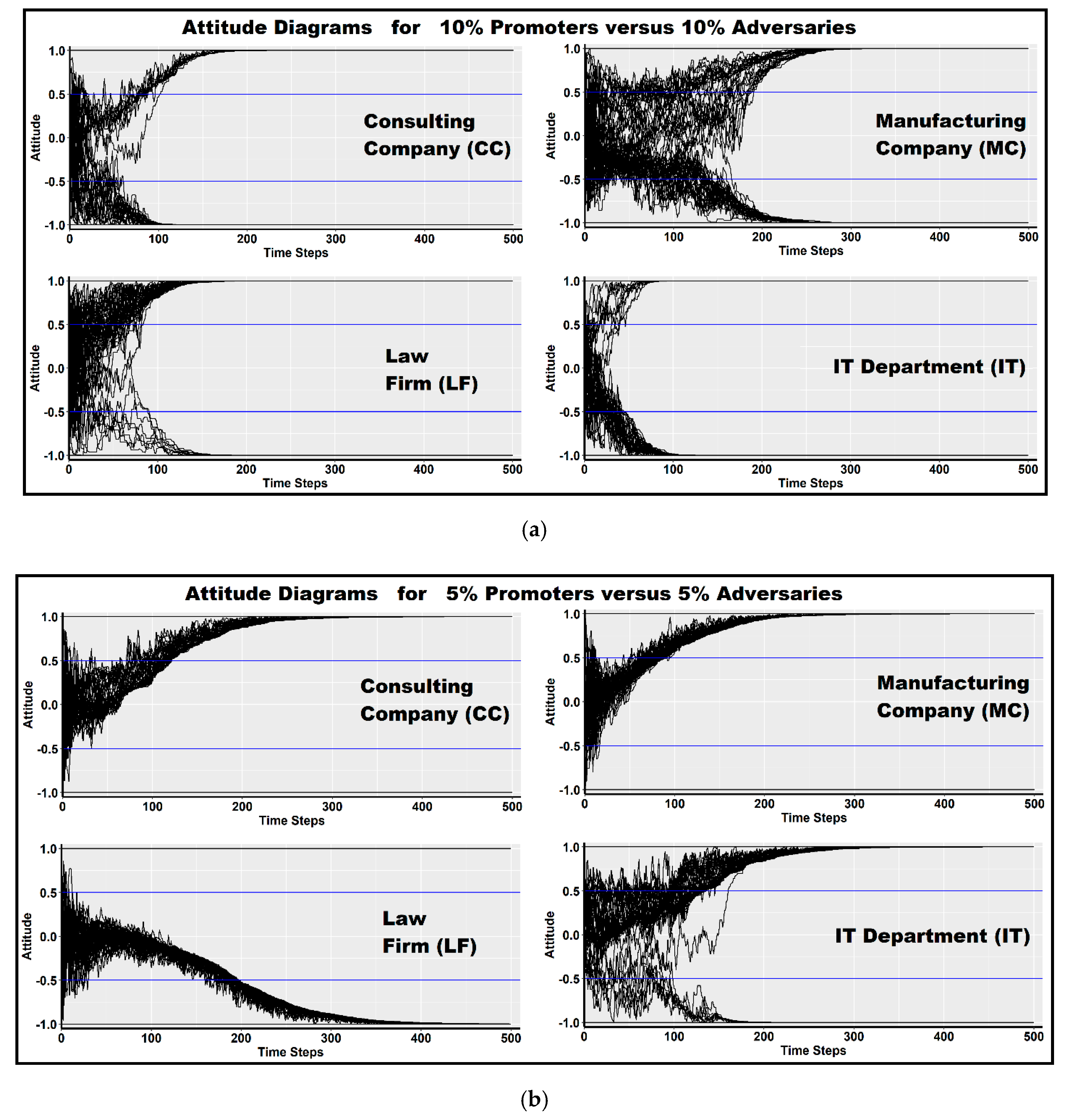
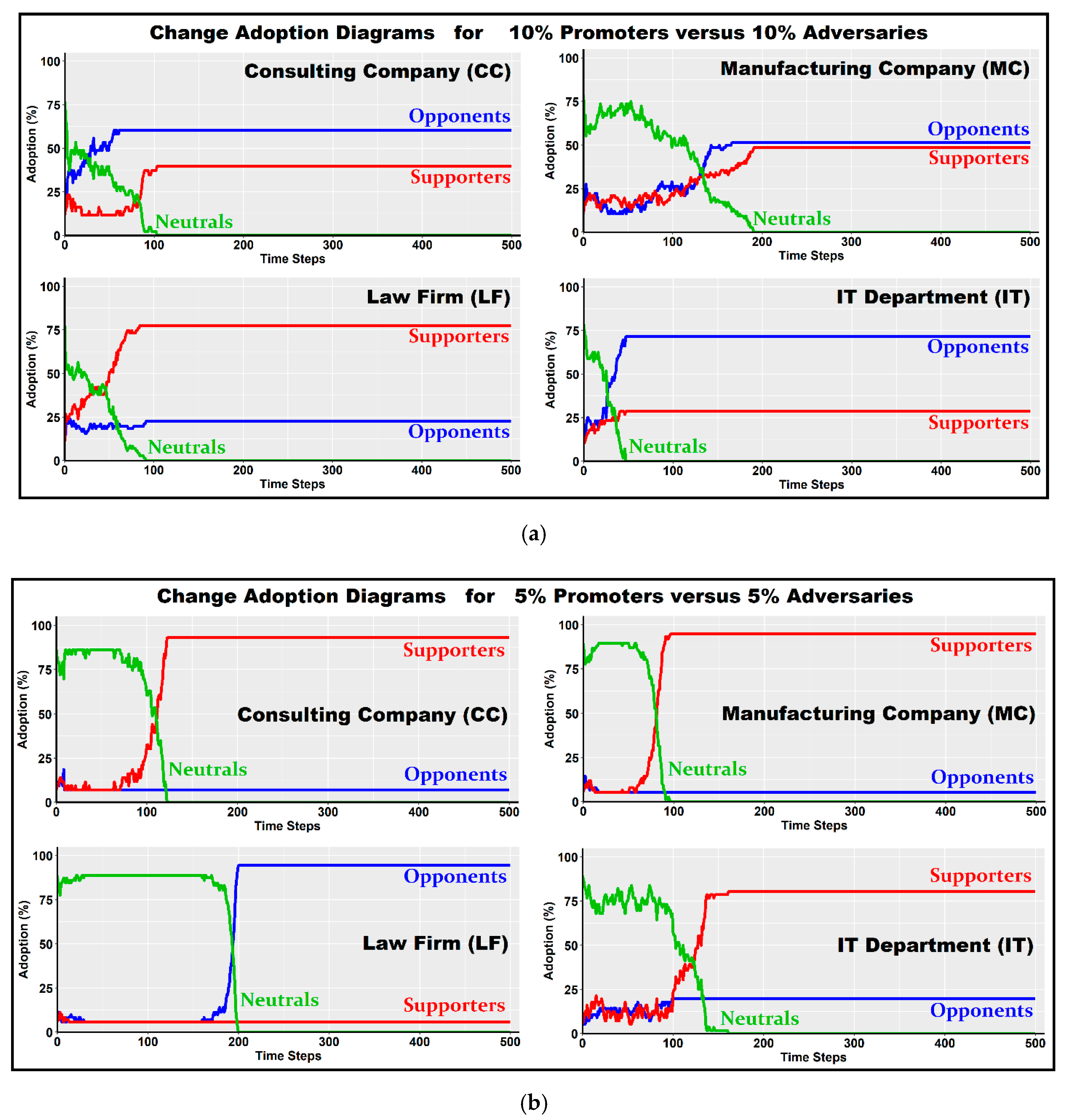
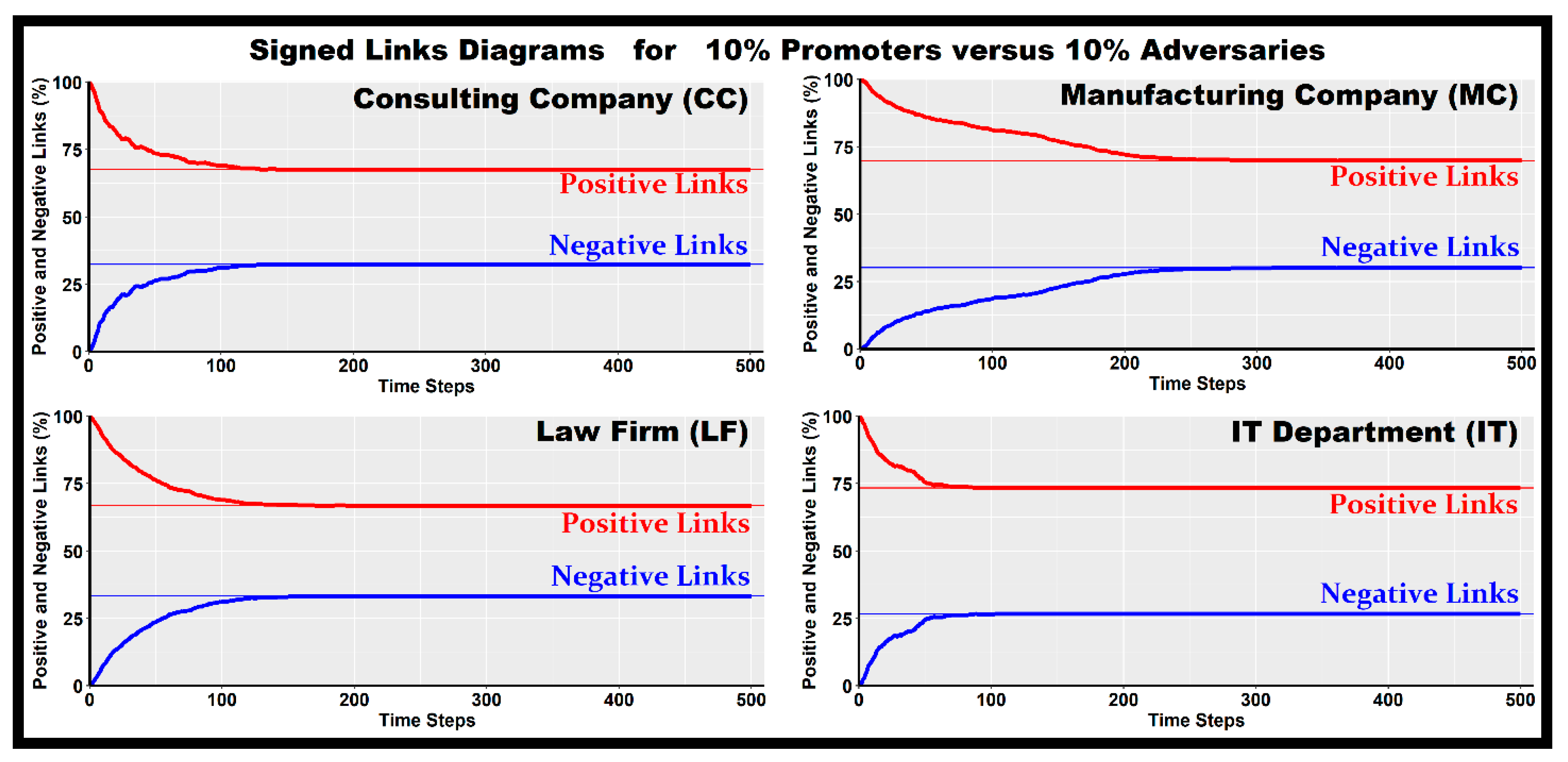
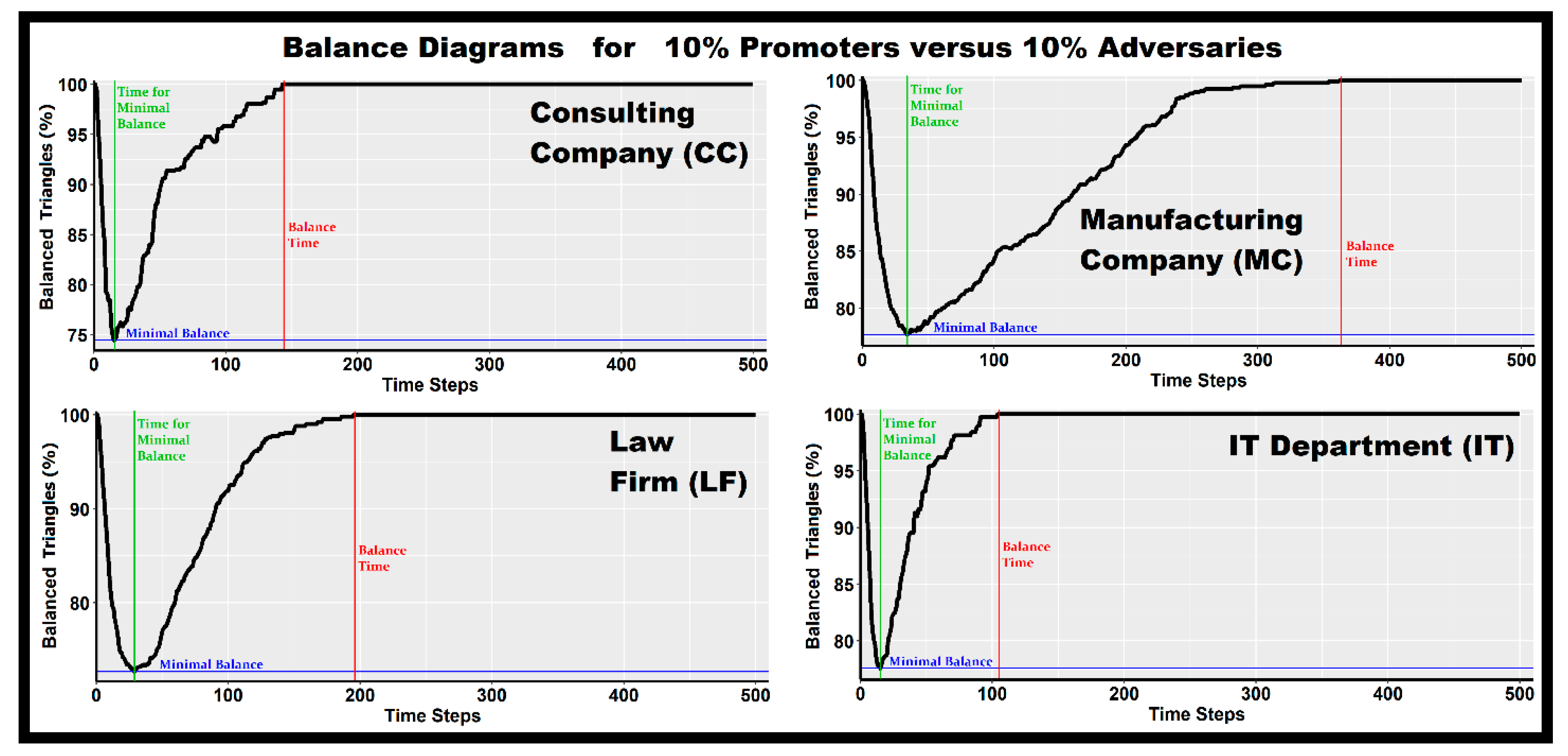
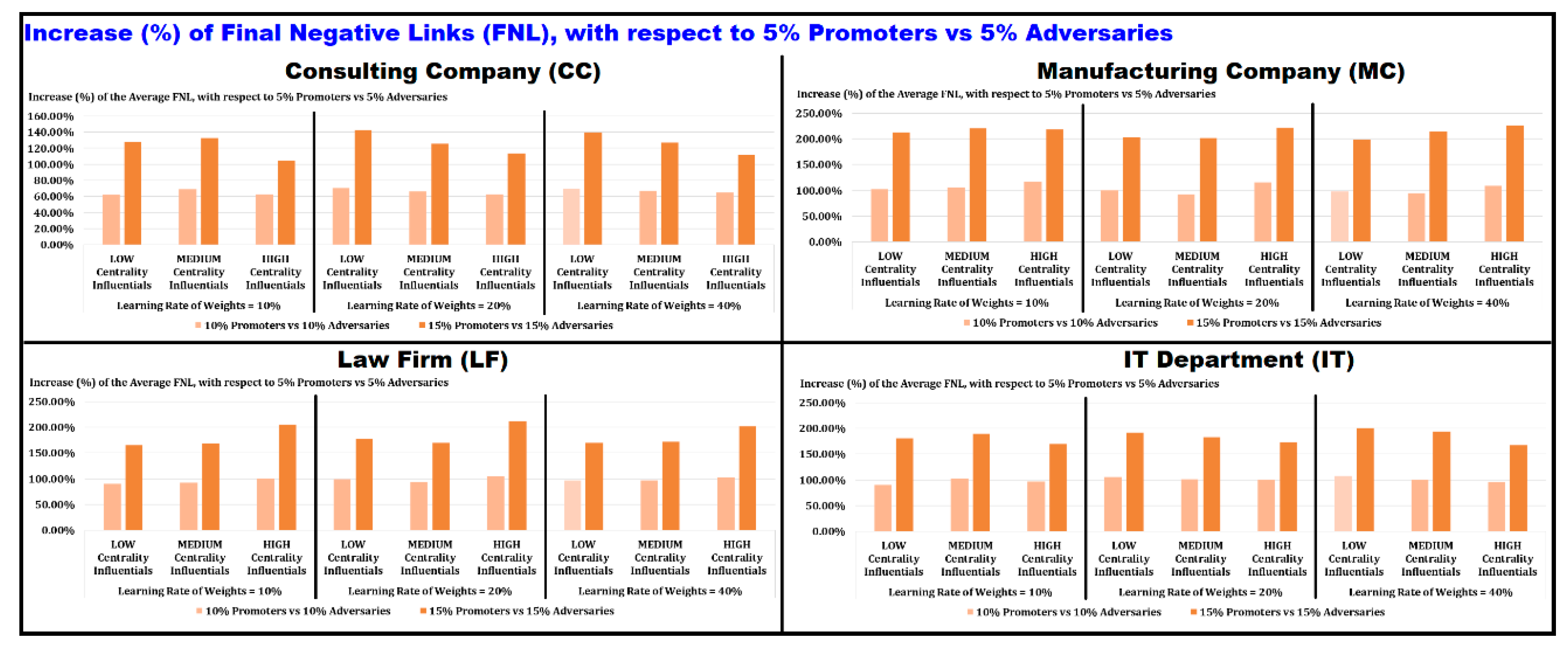
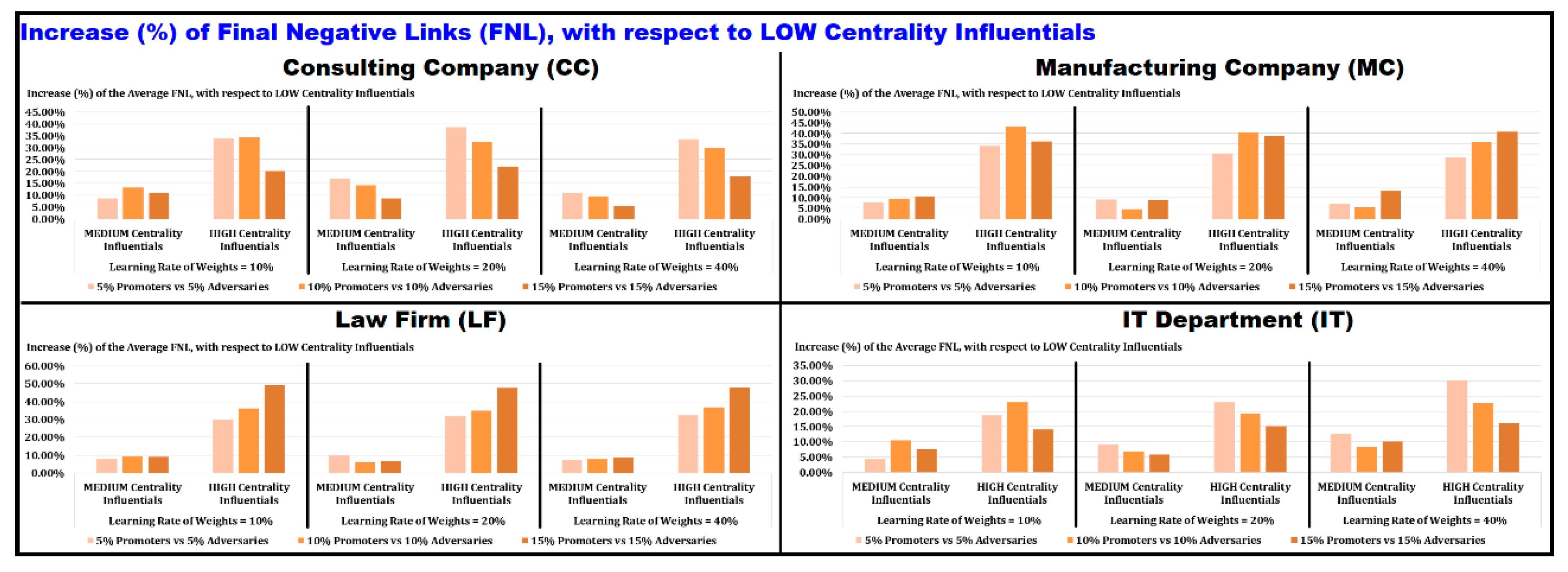
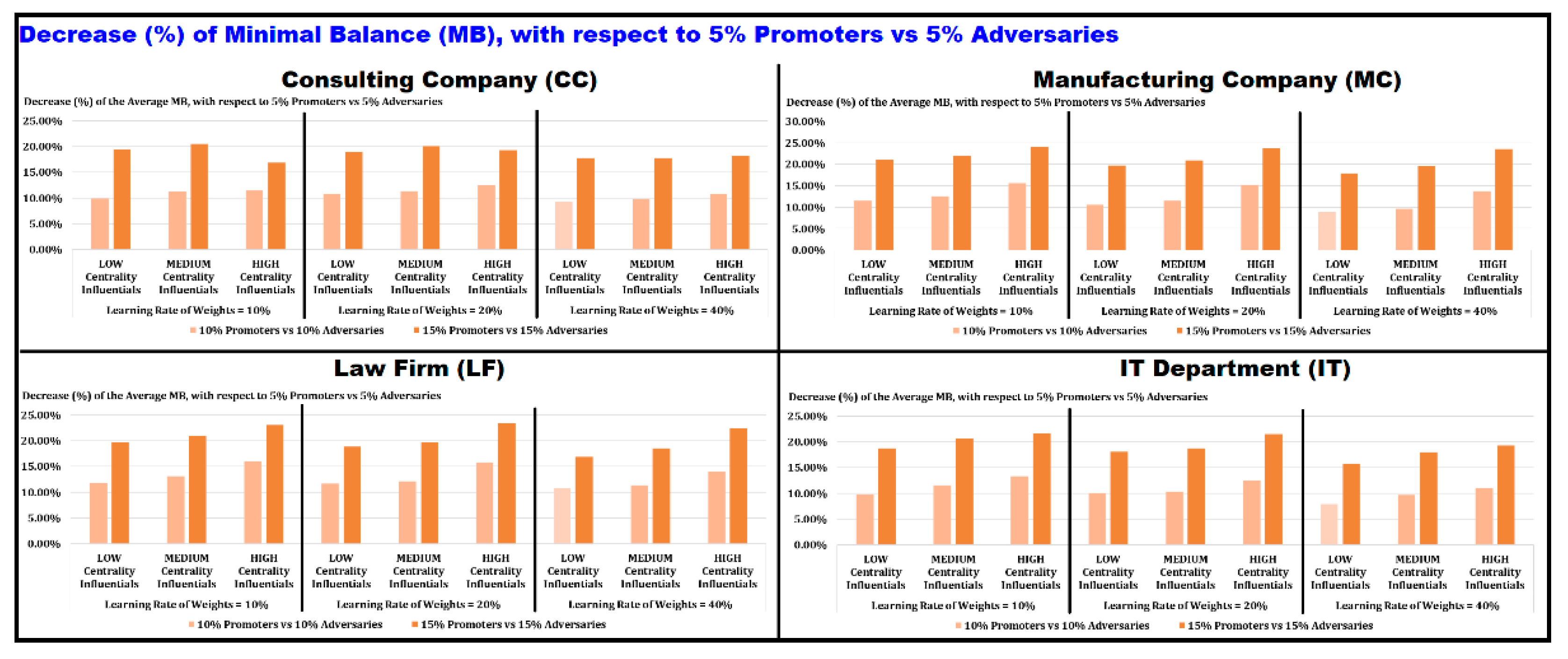
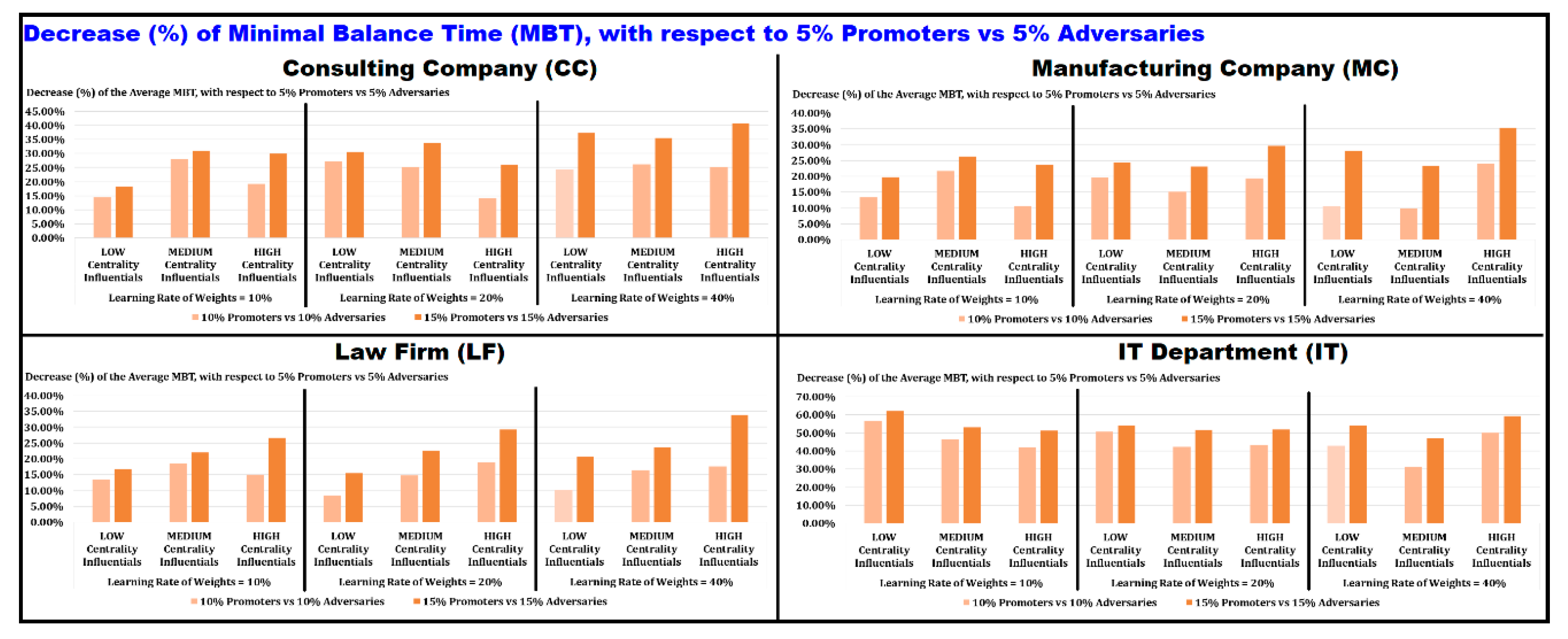
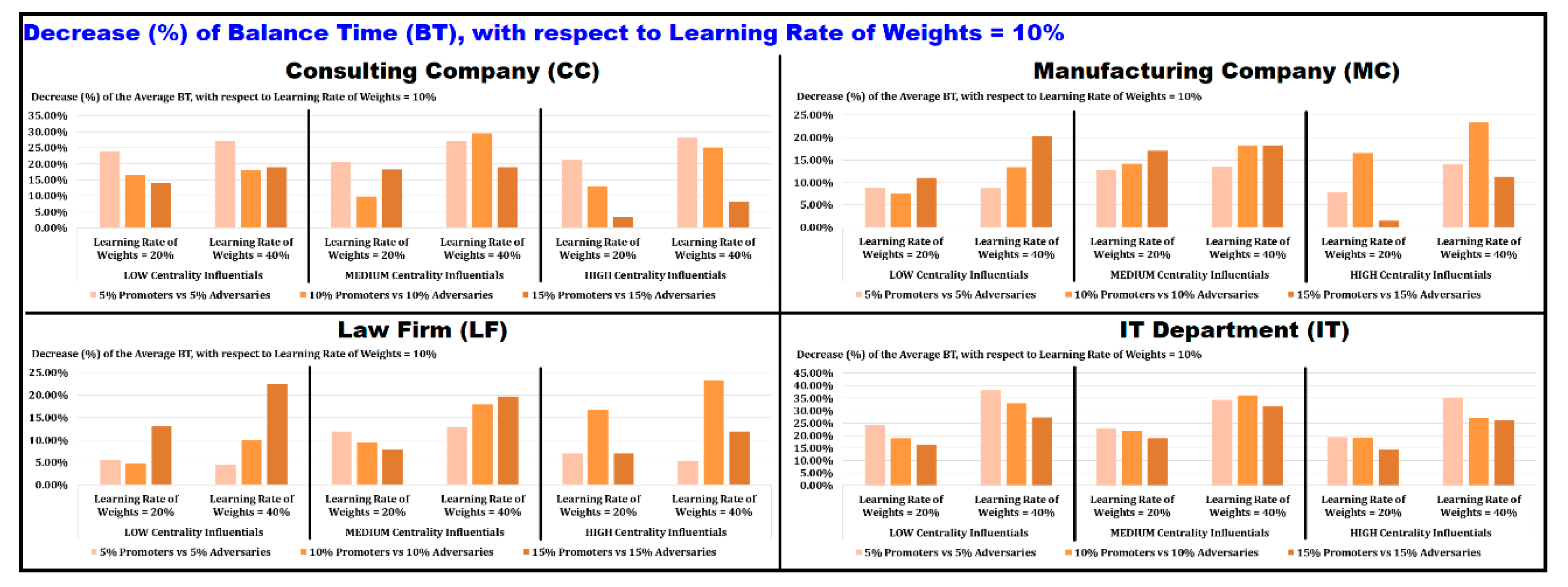
| Perfect Attraction: Agent adopts fully the attitude of agent , as a result of positive influence by agent , through the communication channel , at time . | |
| Attraction: Agent adopts partially the attitude of agent , as a result of positive influence by agent , through the communication channel , at time . | |
| No Influence: There is no (direct) influence from agent to agent , through a communication channel , at time . | |
| Repulsion: Agent moves away from the attitude of agent , as a result of negative influence by agent , through the communication channel , at time . | |
| Perfect Repulsion: Agent moves totally away from the attitude of agent , as a result of negative influence by agent , through the communication channel , at time . |
| (a) | |||||
 | Directed Link | Directed Link | Directed Link | Triangle Category | |
 | I | ||||
| agent perceives agent as “friend” | agent perceives agent as “friend” | agent perceives agent as “friend” | |||
| my friend’s friend is my friend | |||||
 | II | ||||
| agent perceives agent as “friend” | agent perceives agent as “enemy” | agent perceives agent as “enemy” | |||
| my friend’s enemy is my enemy | |||||
 | III | ||||
| agent perceives agent as “enemy” | agent perceives agent as “friend” | agent perceives agent as “enemy” | |||
| my enemy’s friend is my enemy | |||||
 | IV | ||||
| agent perceives agent as “enemy” | agent perceives agent as “enemy” | agent perceives agent as “friend” | |||
| my enemy’s enemy is my friend | |||||
| (b) | |||||
 | Directed Link | Directed Link | Directed Link | Triangle Category | |
 | I | ||||
| agent perceives agent as “friend” | agent perceives agent as “friend” | agent perceives agent as “friend” | |||
| my friend’s friend is my friend | |||||
 | II | ||||
| agent perceives agent as “friend” | agent perceives agent as “enemy” | agent perceives agent as “enemy” | |||
| my friend’s enemy is my enemy | |||||
 | III | ||||
| agent perceives agent as “enemy” | agent perceives agent as “friend” | agent perceives agent as “enemy” | |||
| my enemy’s friend is my enemy | |||||
 | IV | ||||
| agent perceives agent as “enemy” | agent perceives agent as “enemy” | agent perceives agent as “friend” | |||
| my enemy’s enemy is my friend | |||||
| Real Organizational Network | Consulting Company (CC) | |
| Research Team of a Manufacturing Company (MC) | ||
| Partnership network of a Corporate Law Firm (LF) | ||
| IT Department of a Fortune 500 Company (IT) | ||
| Conditioning Factor | Position of Influential Agents (Promoters and Adversaries) | Low Centrality |
| Medium Centrality | ||
| High Centrality | ||
| Number of Influential Agents (Promoters versus Adversaries) | 5% versus 5% | |
| 10% versus 10% | ||
| 15% versus 15% | ||
| “Learning” Rate | 10% | |
| 20% | ||
| 40% | ||
Publisher’s Note: MDPI stays neutral with regard to jurisdictional claims in published maps and institutional affiliations. |
© 2020 by the authors. Licensee MDPI, Basel, Switzerland. This article is an open access article distributed under the terms and conditions of the Creative Commons Attribution (CC BY) license (http://creativecommons.org/licenses/by/4.0/).
Share and Cite
Ioannidis, E.; Varsakelis, N.; Antoniou, I. Promoters versus Adversaries of Change: Agent-Based Modeling of Organizational Conflict in Co-Evolving Networks. Mathematics 2020, 8, 2235. https://doi.org/10.3390/math8122235
Ioannidis E, Varsakelis N, Antoniou I. Promoters versus Adversaries of Change: Agent-Based Modeling of Organizational Conflict in Co-Evolving Networks. Mathematics. 2020; 8(12):2235. https://doi.org/10.3390/math8122235
Chicago/Turabian StyleIoannidis, Evangelos, Nikos Varsakelis, and Ioannis Antoniou. 2020. "Promoters versus Adversaries of Change: Agent-Based Modeling of Organizational Conflict in Co-Evolving Networks" Mathematics 8, no. 12: 2235. https://doi.org/10.3390/math8122235
APA StyleIoannidis, E., Varsakelis, N., & Antoniou, I. (2020). Promoters versus Adversaries of Change: Agent-Based Modeling of Organizational Conflict in Co-Evolving Networks. Mathematics, 8(12), 2235. https://doi.org/10.3390/math8122235







